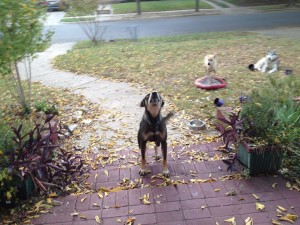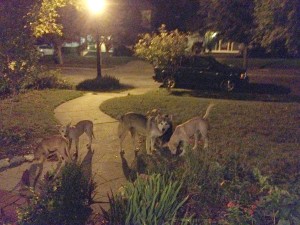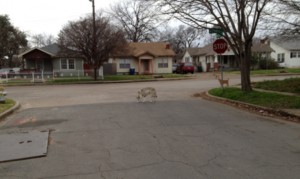Know what to do in an Emergency
If you find yourself in a situation with a loose or aggressive dog and you have a little time and distance, make a u-turn and get out of the dog’s space. If that doesn’t’ work and there is still some space, use what is called the “voice of God”. You know, the voice your Mom used on you when she meant it and was only going to say it once. Use the VOG voice and give a single command “no” or “stay” and a hand out in a low halt position. Do NOT yell – this should be a calm, firm command.

This aggressive guy had to be maced
in order for me to get in my house
He REALLY liked his lady dog friends
I have also use the “Sssttt” sound and then the “no” command in combination with great success. The first “sstt” sound gets their attention, the command stops them.
If an aggressive dog charges you or chases you, be a tree. This is a tough one to do in the panic of a real life situation, but it really works. Teach this trick to your kids, it could save their lives.
Some people carry a stick, but hitting an aggressive dog, generally speaking, only makes the situation worse by escalating the situation. Having have rescued my share of urban street dogs, they DO interpret any stick like object as aggression. It will not help the situation to wield a stick. Experts recommend carrying an umbrella and to deploy it to create a shield. The dogs can’t get hold of a large flat surface to bite it. Craziness. I wish I had known about the umbrella trick when the aggressive dog pack dog was after me on my front porch!
Don’t forget to report the loose or agressive dogs to Animal Control or 911. Click this link to our post that explains how to report loose or aggressive dogs to the city.
Remember, even though it seems counter intuitive, running, yelling, waving your arms around, or trying to hit at the dog with a stick are the least effective ways to defuse the situation. Read more about what to do if a dog attacks and how to stop loose dogs on these links.
So now you are all geared up, emergency prepared and ready to hit the streets. Let’s talk about what you might encounter on your walk.
How dogs approach each other
I am not a trainer or a behaviorist, (I can recommend some if you need one), but here is a thing that I have observed watching our neighborhood dog pack. (Yes, we had an honest to goodness dog pack on and off for two years). The dogs would charge up to each other at 90 miles an hour and then dead stop and hold still. At first I wondered who knew who and if they were old friends or new friends – but that’s how they greeted everyone.
The entire pack would rush up on the “new guy” and surround him. Everyone would hold still (somewhere in here “be a tree” becomes relevant”), sniffing while still – saying who knows what to each other – and then one of them would make the first move and they would all move off like a pack again. The first couple times I saw this I thought there was going to be a dog fight, but to my surprise, nothing. It was no big deal.This is important to you because your dog is on a leash. Loose dogs will rush and literally RUN up on you. The natural pack interaction and reaction is not possible on the leash. Your dog is also walking and packing with its human, and its job is to defend you. Your dog will not react the same way when walking with you than if it was just loose and at a wild dog party. Have some mace, be prepared to keep loose dogs out of your space if things go south.
I’m going to sound like a broken record robot: Pack the mace or the citronella spray. If you don’t think that you will likely have an encounter with a loose, aggressive, or unaltered male dog in an urban neighborhood, you might want to ask around. Every dog owner has at least one story. Prevention and planning are the keys to keeping your pets safe and enjoying your daily walk. Let me say that again, PREVENTION and PLANNING are the keys to keeping your pets safe and to enjoying your daily walk.
You are now looking good, relaxed, and confident because you are prepared. Let’s talk about what happens on your daily route: Part 3 – Barking dogs are generally not happy to see you…








